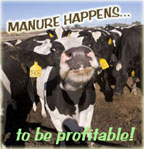|
|
 |
|
 |
|
California Home
|
|
|
|
Comprehensive Nutrient Management Plan (CNMP)Last Modified: 10/21/2008 09:39 AM  A Comprehensive Nutrient Management Plan (CNMP) is a conservation plan that is unique to animal feeding operations. It is a grouping of conservation practices and management activities, which, when implemented as part of a conservation system, will help to ensure that both production and natural resource protection goals are achieved. The objective of a CNMP is to document the Animal Feeding Operation (AFO) owner's and/or operator's plan to manage water, manure and organic by-products by combining conservation practices and management activities into a conservation system that will help achieve the goals of the producer, control soil erosion, and protect or improve water quality. A CNMP addresses the following elements of the AFO:
The CNMP document itself is organized into different sections that include:
Air quality considerations for dairy producers are substantial. Pollutants typically generated by dairies include ammonia, nitrous oxides, other oxides of nitrogen, Volatile Organic Compounds (VOC) and dust. The following links can be used to assist with planning for limited air emissions from the dairy.
Assistance with meeting regulations for dairies in the Central Valley is available though the Environmental Stewardship Program of the California Dairy Quality Assurance Program (CDQAP). The final regulations adopted by the Regional Water Quality Control Board, Region 5, for Milk Cow Dairies in the Central Valley are provided here for your convenience. To obtain more information on regulations affecting AFOs in the Central Valley and other parts of California go to the State Water Resources Control Board/Regional Boards. Producers who want fundamental information on CNMP should go here. Producers may also want to review the documents on this site designed for Technical Service Providers (TSP) and NRCS employees assisting with CNMP preparation. NRCS Employees and Technical Service Providers (TSPs) who want to learn about getting certified as CNMP providers or who want technical information and tools should go here. NRCS uses the Manure Management Planner (MMP) Tool as part of the CNMP plan. Click here for more information on this program. Success StoriesIf you encounter problems with the files provided on this page, please contact the Webmaster. This document requires
Acrobat Reader. |
|
|
|